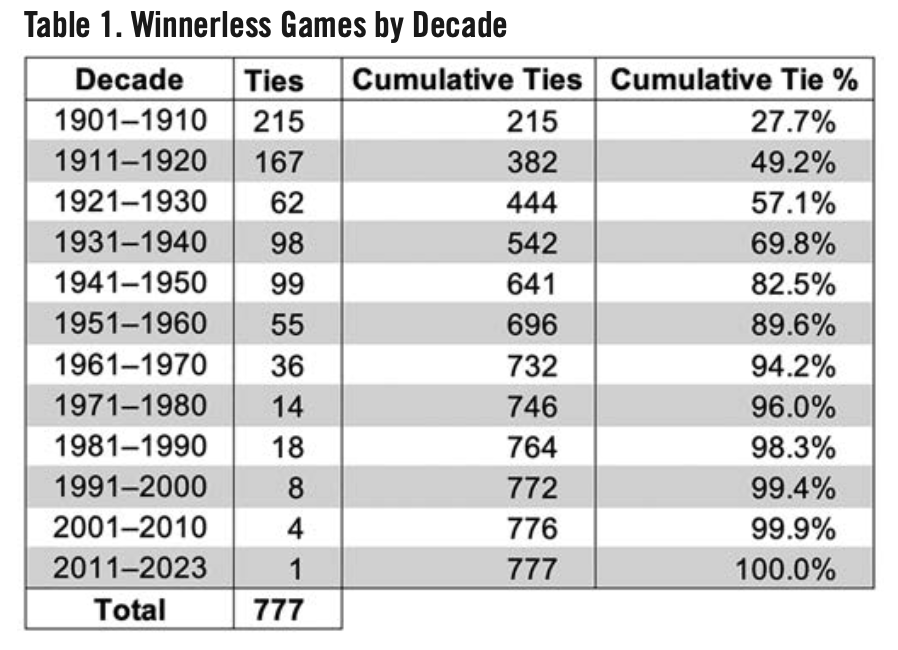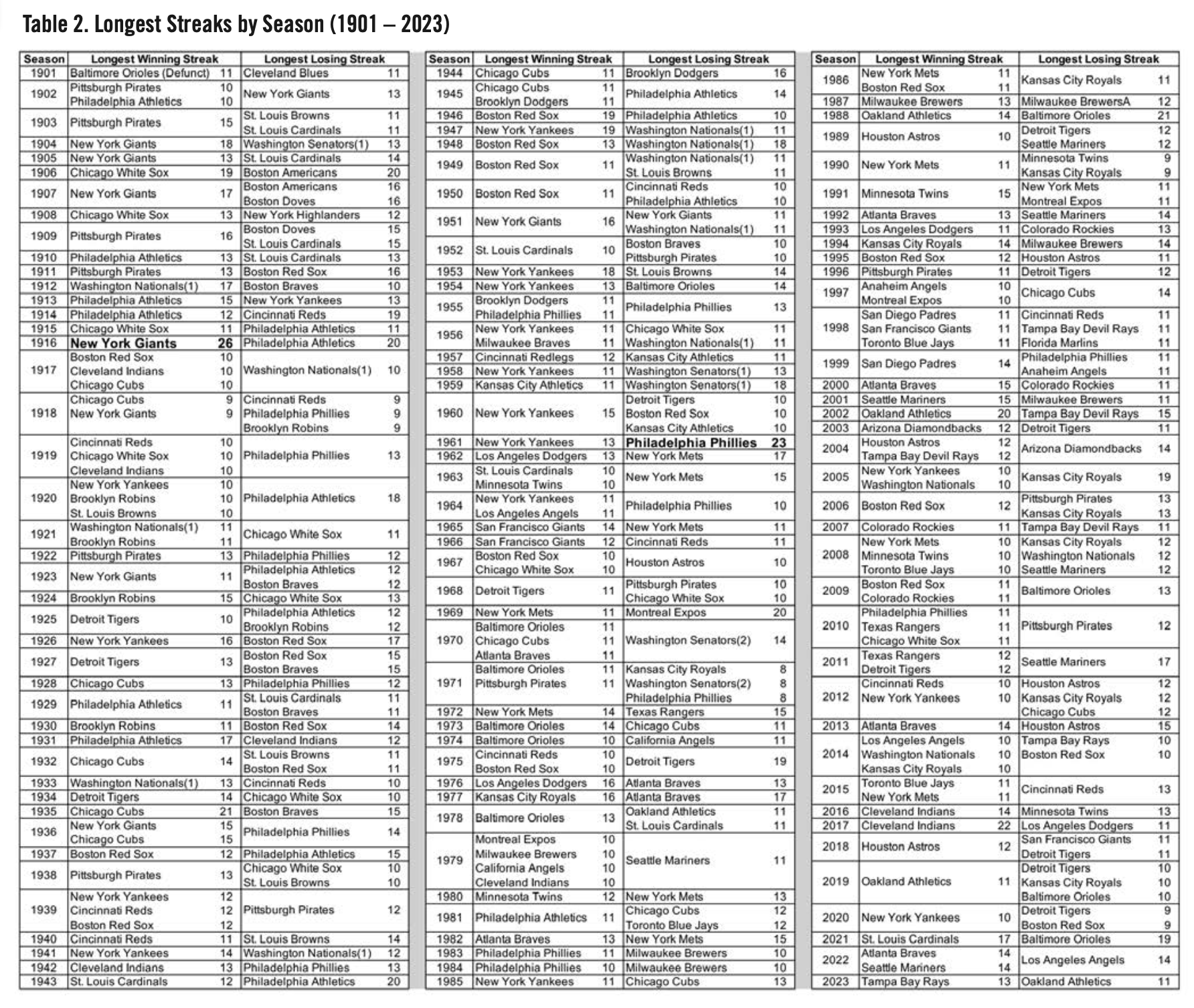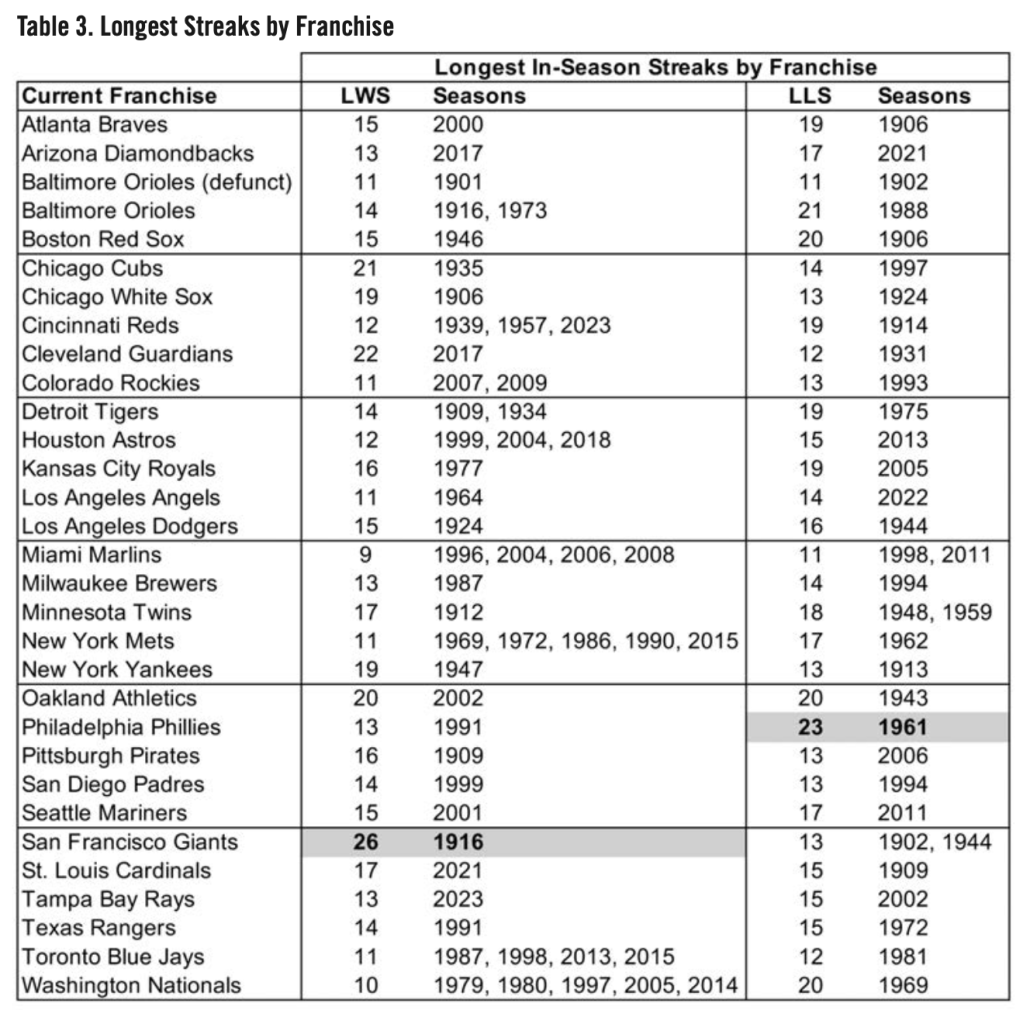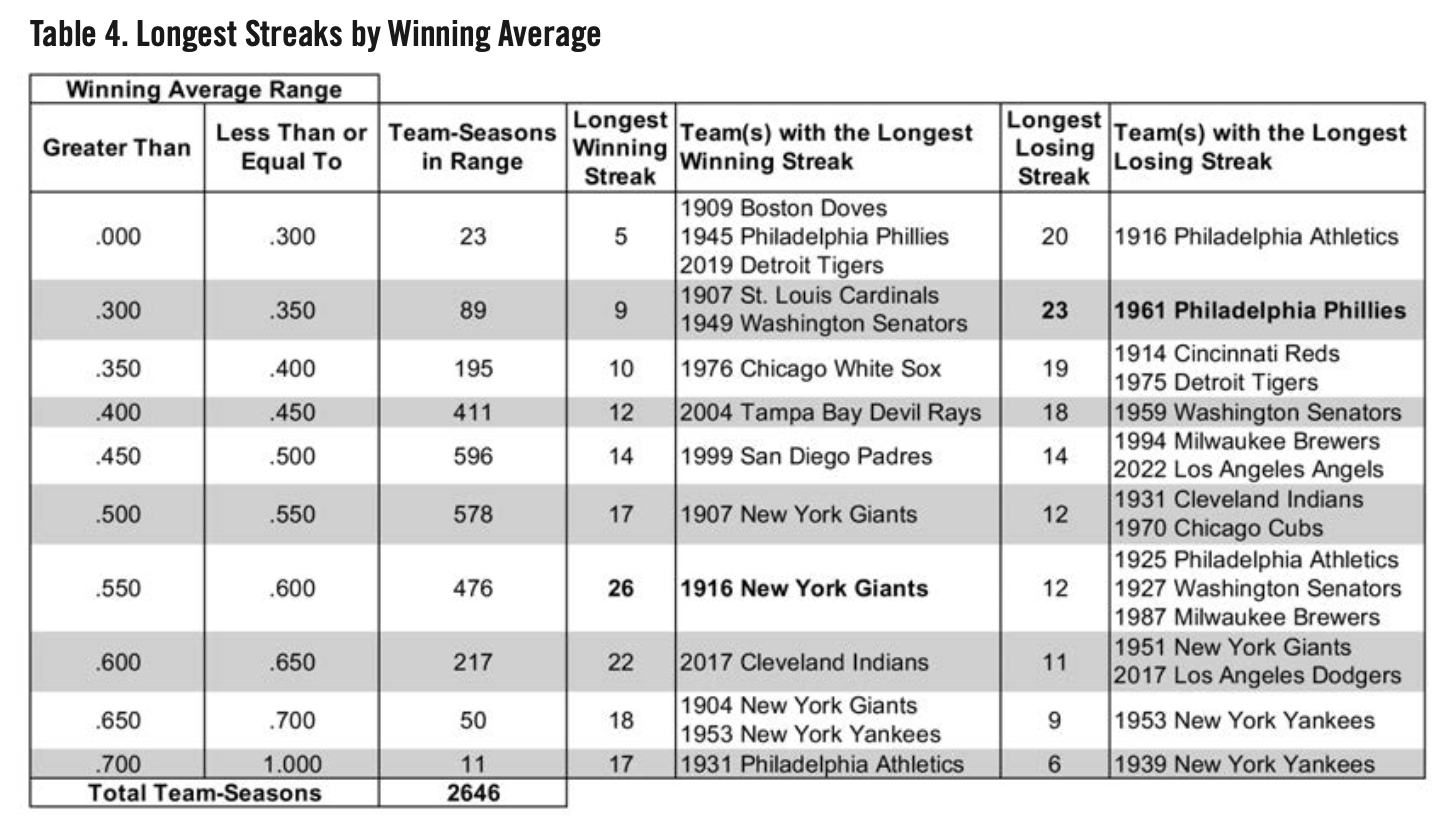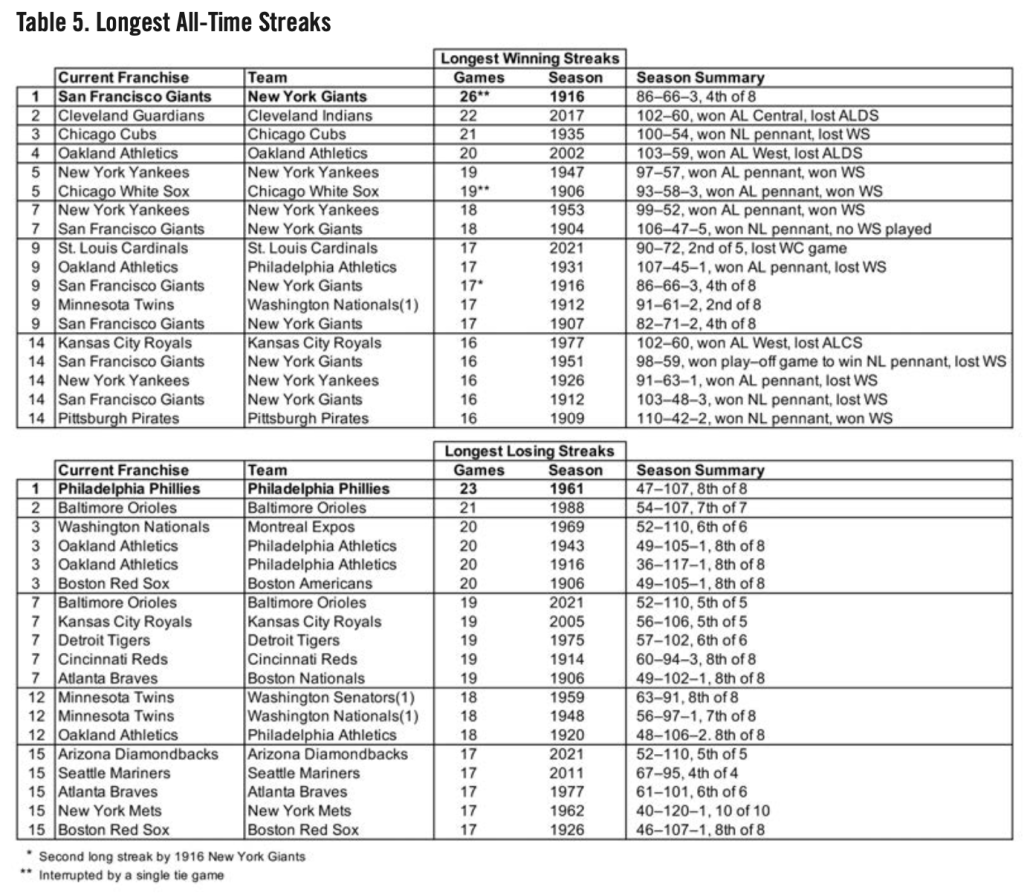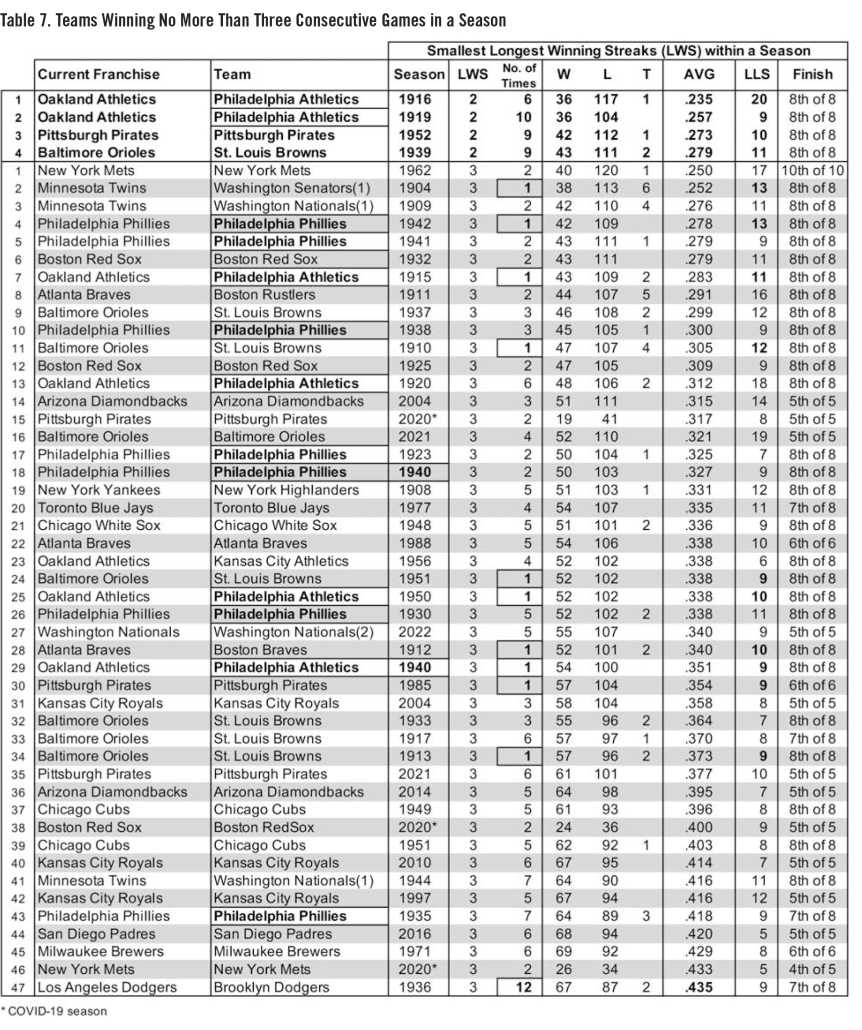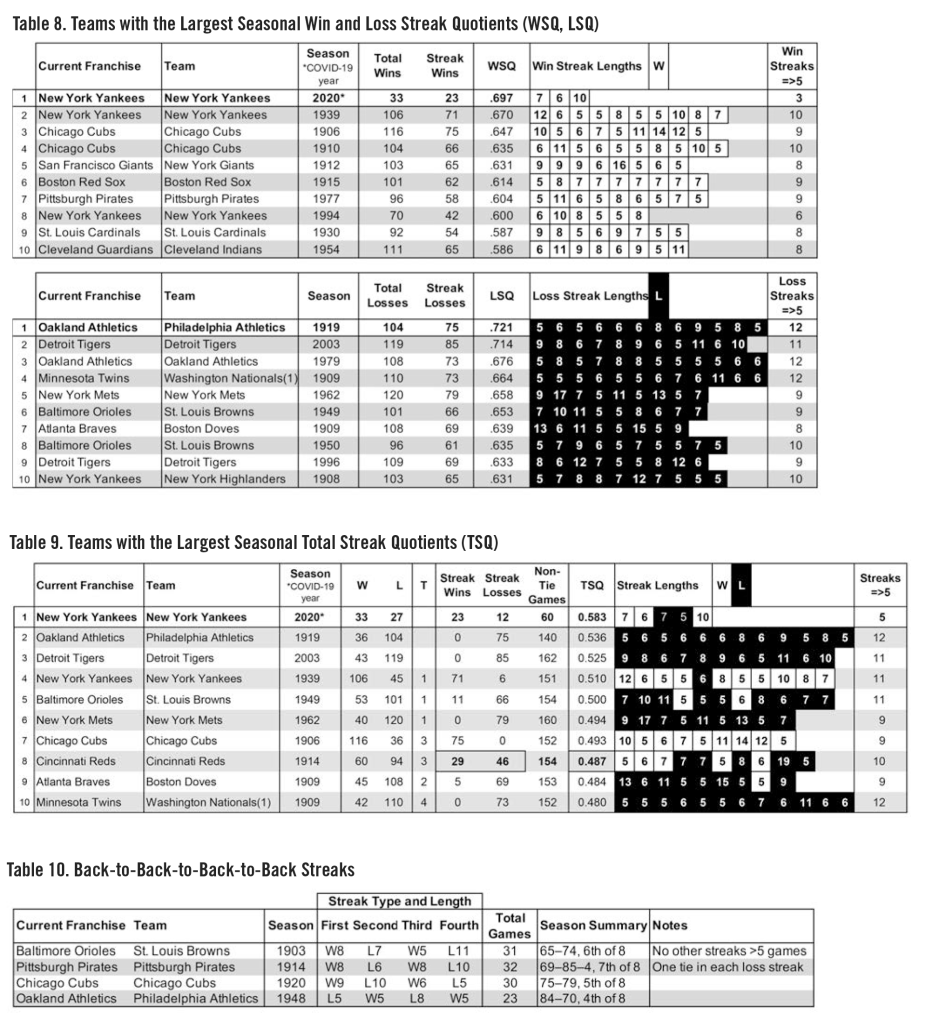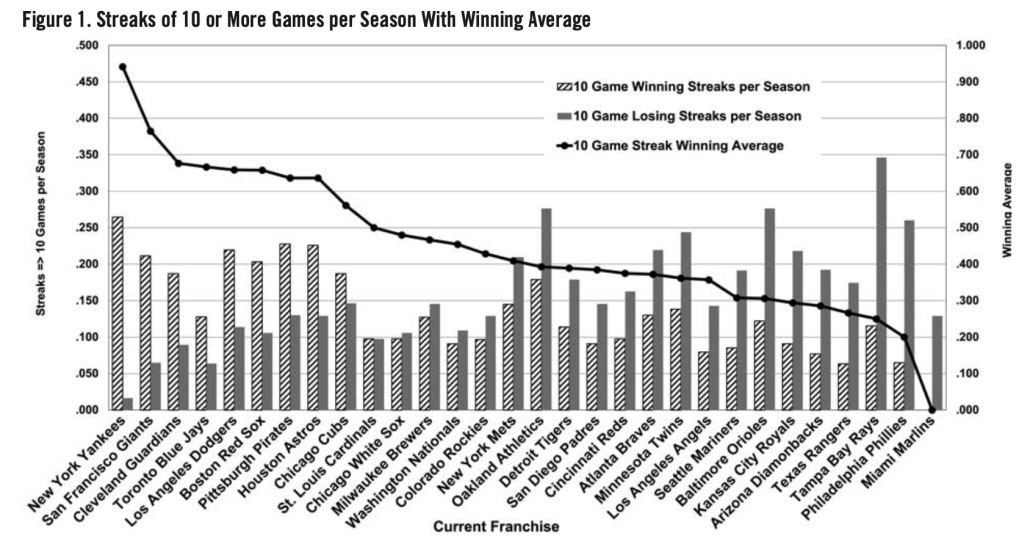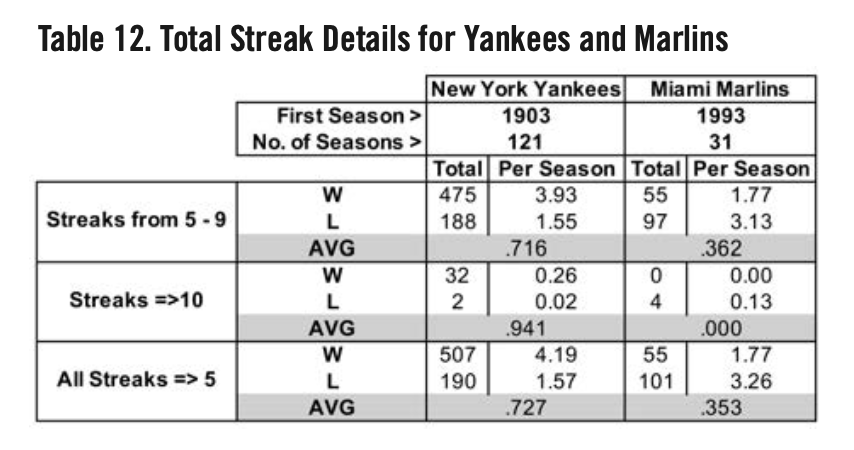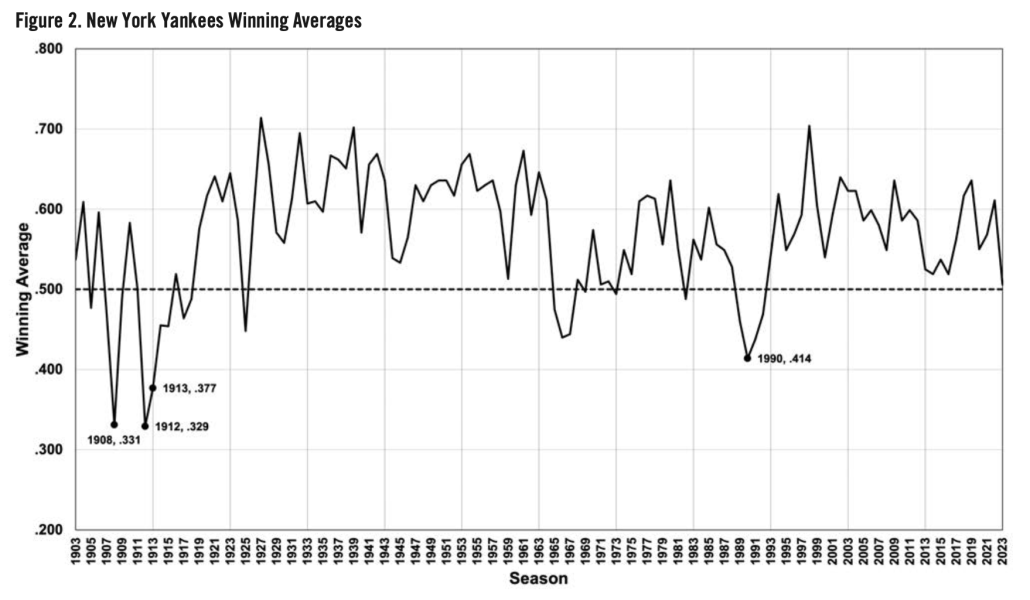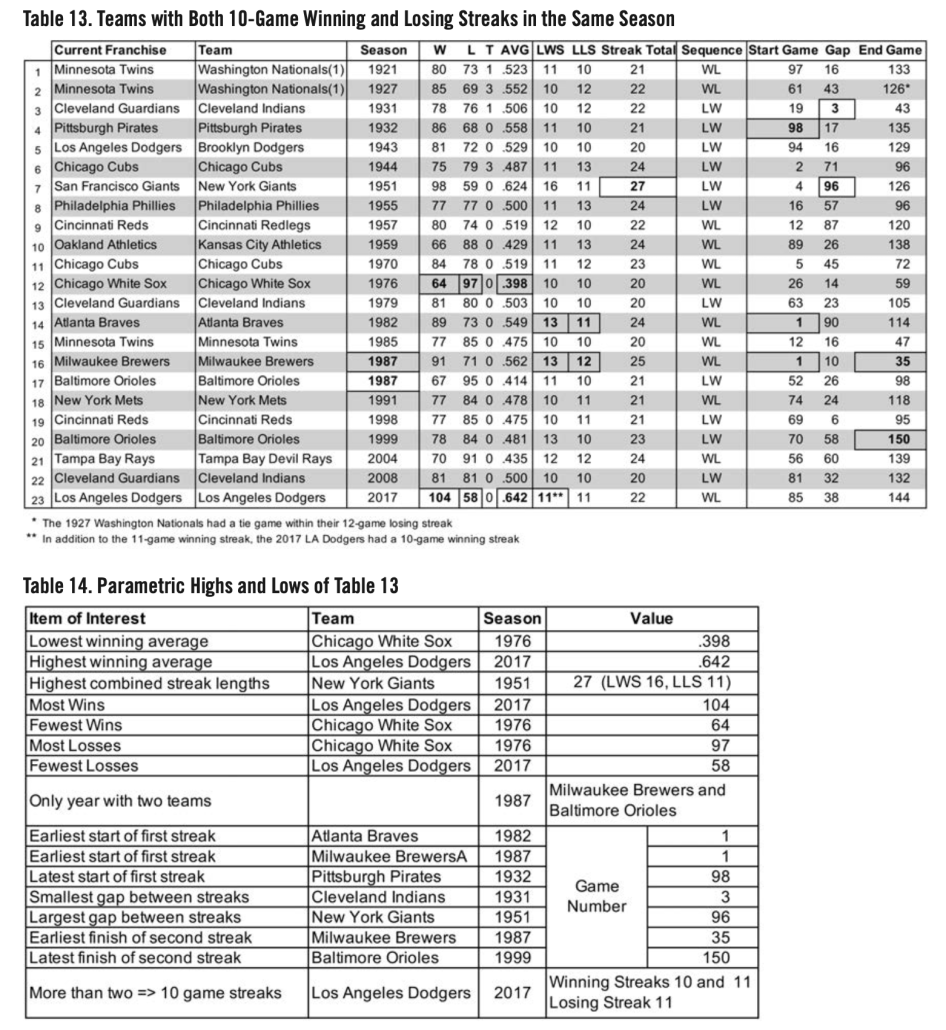Scanning the World of Baseball Streaks: Part Two
This article was written by Ed Denta
This article was published in Fall 2024 Baseball Research Journal
In “Going Beyond the Baseball Adage ‘One Game at a Time’: A Geek’s Peek at Streaks,” published in the Spring 2024 Baseball Research Journal, I developed a set of mathematical expressions to predict the frequency and length of baseball’s winning and losing streaks. In this paper, I will highlight the historical content I uncovered during my research, diving into notable accomplishments such as the longest winning and losing streaks in each season and for each franchise, and crowning the streakiest teams of all time. If you are fascinated by baseball history and crave new insights into the triumphs and tribulations of some of the best and worst teams of all-time, this paper is for you.
STREAKS DEFINED
Of the 206,711 games in my data set played from 1901 to 2023, 777 had no determined winner. Ties and suspended games were quite common in the first half of the twentieth century, mainly due to fields not having lights. Suspended games were not always completed at a later date, and 89.6% of all games with no determined winner occurred by 1960. The last tie game occurred on September 29, 2016, when rain halted the Cubs and Pirates in the top of the sixth inning with the score tied, 1–1. The game was called rather than suspended because it was late in the season and the result would have had no effect on the standings. Table 1 shows the number of winnerless games by decade.
For purposes of this paper, games with no winner are considered a neutral result. They neither terminate nor extend a streak. For example, the nine-game sequence WWWTWWTWW is considered a seven-game win streak. This paper addresses only streaks that occur within a single season and does not differentiate between home and away games. Home and road streaks are thought-provoking topics for another report.
LONGEST STREAKS BY SEASON
Table 2, shows the longest winning and losing streaks in each season from 1901 through 2023. All current franchises (including the defunct Baltimore Orioles) have led (or tied) for the longest seasonal win streak at least once, except for the Marlins. The Yankees have done so most often, posting the longest win streak 16 times. Only the Padres have never had the longest losing streak, while Red Sox own the dubious distinction of running the longest losing streak in 18 different seasons. In 1971, the Royals, Phillies, and Senators tied for the longest losing streak in baseball with eight consecutive losses. That was the only season where the leader in either wins or losses had fewer than nine. In 1918, the Cubs and Giants led baseball with nine-game win streaks, while the Reds, Phillies, and Brooklyn Robins led with nine-game losing streaks, making it the only season when no team reached double digits in either category.
(Click image to enlarge)
LONGEST STREAKS BY FRANCHISE
Table 3, below, shows the Longest Winning Streak (LWS) and Longest Losing Streak (LLS) for each current franchise. The Miami Marlins are the only franchise without a double-digit win streak.
(Click image to enlarge)
LONGEST STREAKS BY WINNING AVERAGE
Table 4, below, buckets teams based on their winning average, then shows the longest winning and losing streaks for each bucket. For example, of the 23 teams with a winning average below .300, the 1909 Boston Doves, 1945 Phillies, and 2019 Tigers were the only squads that put together a five-game winning streak. The 1939 Yankees stand alone as the only team to run a six-game losing streak despite achieving a winning average above .700.
In 1953, the Yankees posted a 99–52 record, good for a .656 winning average, and cruised to the American League pennant by 8½ games. A week after reeling off 18 consecutive wins from May 27 through June 14, they proceeded to lose nine games in a row. These two streaks represent the longest winning and losing streaks for a team that finished the season with a winning average above .650.
(Click image to enlarge)
LONGEST ALL-TIME STREAKS
Table 5, lists the longest winning and losing streaks of all-time. The 1916 New York Giants had two winning streaks that made the list: a 17-game streak in May and a 26-game streak (interrupted by a tie) in September. Amazingly, the May streak occurred entirely on the road while the September streak took place exclusively at home. Sadly, the Giants finished in fourth place at 86–66–3, seven games behind the pennant-winning Brooklyn Robins.
(Click image to enlarge)
SHORTEST LOSING STREAKS
Great teams are resilient after a loss, finding ways to avoid long losing streaks. Table 6, below, lists all the teams that lost no more than three consecutive games in a season. That is, their longest seasonal losing streak (LLS) was no more than three games. Entries are sorted by LLS and then by winning average.
Only two teams have ever gone through an entire season without losing more than two games in a row: the 1902 Pirates and the 2020 Dodgers. The Pirates lost consecutive games eight times during 1902. On July 7, they avoided a three-game losing streak by scoring three runs in the bottom of the eighth inning to pull out a 5–3 victory over the Phillies. These juggernaut Pirates, led by future Hall of Famers Honus Wagner, Fred Clarke, and Jack Chesbro, outscored their opponents 775 to 440, finished with a 103–36–3 record, and cruised to the pennant with a 27½ game cushion over the second place Brooklyn Superbas. Only two other National League teams finished above .500 that season. During the abbreviated 2020 season, the Dodgers lost consecutive games four times. They came closest to losing three in a row on September 8 against the Diamondbacks. Trailing 6–2 after six innings, they scored four runs in the top of the seventh to tie the game. In the 10th inning, they scored four runs to Arizona’s three, scraping by with a 10–9 victory.
There have been 41 other occasions when a team did not lose more than three games in a row. Of those clubs, only the 1906 Chicago Cubs were able to limit their three-game losing streak to a single occurrence. At .763, they also posted the highest winning average on the list. On the other hand, the 1972 New York Mets lost three consecutive games on 12 occasions and their .532 winning average was the lowest of the group. In 1954, despite posting a .669 winning average and losing three games in a row just twice, the Yankees missed the playoffs. Despite running four different losing streaks of at least three games, including two in the first nine games of the season, the Cleveland Indians—not included in the table due to a four-game losing streak—ran away with the pennant with a record of 111–43–2, for a winning average of .721.
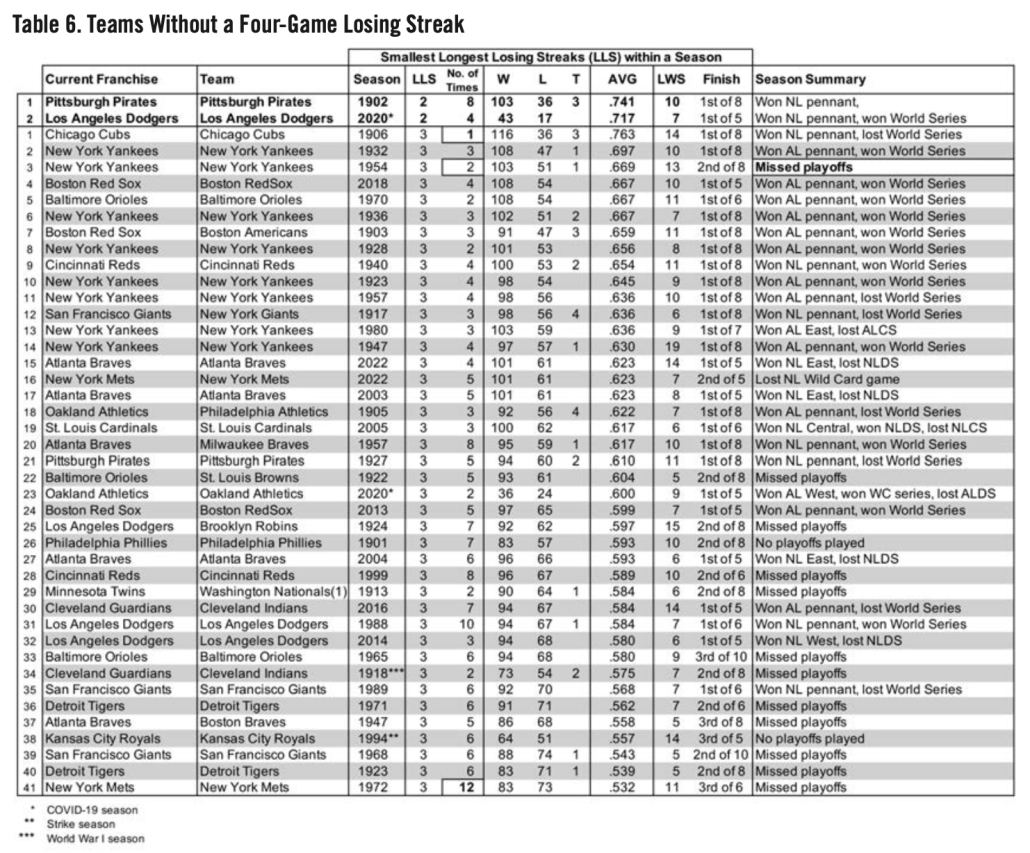
SHORTEST WINNING STREAKS
Bad teams find it difficult to break out of downward spirals. Any combination of factors can inform their struggles: inferior talent, leadership, or ownership, a poor clubhouse atmosphere, injuries, or maybe even just bad karma. Table 7, lists all teams that won no more than three consecutive games in a season. That is, their longest seasonal winning streak (LWS) was no more than three games. Entries are sorted by LWS and then by winning average.
(Click image to enlarge)
Four teams have failed to win more than two consecutive games during an entire season: the Philadelphia Athletics of 1916 and 1919, the 1939 St. Louis Browns, and the 1952 Pirates. Each of these abysmal squads did win consecutive games at least six times. From 1909 through 1914, the Athletics were the top team in baseball, winning four pennants and three World Series, and never finishing worse than third in the American League. The roster was decimated for 1915, when frugal owner (and manager) Connie Mack sold Eddie Collins to the White Sox, had Home Run Baker sit out the season due to a contract dispute, and allowed Eddie Plank and Chief Bender to jump to the new Federal League by failing to offer comparable salaries. The basement of the AL became Mack’s home for the next seven seasons.
In the eight seasons from 1950 to 1957, the Pirates finished in last place in the National League five times and second-to-last three times. Despite reaching their nadir in 1939, the Browns hadn’t won more than four straight games in any of the three previous seasons.
There have been 47 other occasions when a team failed to win more than three games in a row, including 10 teams that only managed one single three-game winning streak. The 1936 Brooklyn Dodgers had 12 three-game win streaks and finished with a .435 winning average, the best of the group. Between 1915 and 1950, Philadelphia was home to 13 teams that failed to win more than three games in a row. In the 1940 season, neither the Phillies nor the Athletics did so. The Phillies finally brought some elation to the long-suffering fans of Philadelphia by capturing the National League pennant in 1950. Unfortunately, joy turned to disappointment when the Yankees swept the World Series, holding the Phillies to just five runs in four games.
MEASURING STREAKINESS
“A Geek’s Peek at Streaks” established a method for quantifying a team’s streakiness. Win Streak Quotient (WSQ) and Loss Streak Quotient (LSQ) represent the ratio of wins or losses, respectively, that occur during winning or losing streaks of at least five games. Total Streak Quotient (TSQ) combines those two numbers, showing the ratio of all decisions (wins and losses, but not ties) that occur during either a winning or losing streak. Table 8, displays the teams with the largest WSQs and LSQs. The streak lengths are listed in the order that they occurred during the season.
Table 9 displays the teams with the 10 largest seasonal Total Streak Quotients (TSQ). All streaks of five or more games are listed.
Most of the teams in the top 10 were streaky in one particular direction: four only had losing streaks and one only had winning streaks. Despite finishing in last place in the NL, the most balanced team in the top 10 (not counting 2020) is the 1914 Cincinnati Reds, who ranked eighth with a TSQ of .487. Those Reds had five winning streaks and five losing streaks of at least five games, totaling 29 streak wins and 46 streak losses.
(Click image to enlarge)
BACK-TO-BACK-TO-BACK-TO-BACK STREAKS
Back-to-back streaks of at least five games each (a winning streak followed immediately by a losing streak, or vice versa) occur with reasonable regularity. Back-to-back-to-back streaks are not that uncommon. However, stringing together four streaks in a row is a rarity. It has happened just four times and only once since 1920. Table 10 shows these extremely rare streak sequences.
STREAKS OF 10 OR MORE GAMES BY FRANCHISE
Table 11 lists the total number of winning and losing streaks of 10 or more games for each current franchise. The Yankees boast the most winning streaks and the fewest losing streaks. They are also one of just nine franchises with more winning streaks than losing streaks. In order to provide a better comparative assessment, Figure 1 normalizes the data in Table 11 based on the number of seasons each franchise has played. The Yankees and the Marlins represent opposite ends of the streak spectrum.
(Click images to enlarge)
In their 121-year history, the Yankees have gone on more than twice as many winning streaks of five or more games per season than the Miami Marlins (4.19 to 1.77). They have also gone on fewer than half as many losing streaks (1.57 to 3.26). This disparity is even more pronounced when considering streaks of 10 games or more. The Yankees have had 32 winning streaks, while the Marlins have had zero in their 31 years of existence. On the losing side, the Marlins have had four losing streaks of 10 or more games, while the Yankees have had half as many in nearly four times as many seasons. Perhaps more impressive, neither of the Yankees’ losing streaks of ten-plus games have come in the last 110 years.
The only long losing streaks in Yankees history were 12 games in 1908 (when they were sometimes also called the Highlanders) and 13 games in 1913. The 1908 season represents the nadir of the franchise. They finished in last place in the American League, 39½ games out, with a record of 51–103–1. On June 9, they had a winning record of 23–20. They then proceeded to lose 52 of their next 62 games, including 19 losses in 20 games starting on July 23. By August 18, they had fallen to 33–72. In 1912, the team went 50–102–1, with a season-long losing streak of nine games. On June 6, 1913, following a 13-game losing streak, the Yankees found themselves with a record of 9–34–2. They then rallied to compile a 48–60 record over the final 108 games, escaping the American League cellar and finishing at 57–94–2. Never again would they finish a season with a winning average below .414 (Figure 2).
(Click image to enlarge)
SEASONAL YIN AND YANG
Table 13 shows the 23 teams with both a winning streak and a losing streak of at least 10 games in the same season. The 1982 Atlanta Braves and the 1987 Milwaukee Brewers ran off 13-game winning streaks to start their seasons, then later had losing streaks of 11 and 12 games, respectively. The Tampa Bay Rays started 2023 with a 13-game win streak, but never lost more than seven games in a row that season. Table 14 summarizes the highs and low of various entries.
(Click image to enlarge)
FINAL REMARKS
Winning and losing streaks are an under-researched corner of baseball history, making the news only when some particularly great or terrible team approaches a record. In writing this paper, I uncovered many new insights that helped me foster a keener awareness of baseball’s rich history:
- The Marlins are the only team that has never run the longest winning streak, while only the Padres have never run the longest losing streak. The Yankees have led baseball with the longest seasonal winning streak 16 times, but only twice with the longest losing streak.
- The 1982 Braves, 1987 Brewers, and 2023 Rays are the only teams ever to begin a season with 13 straight wins. Both the Braves and the Brewers ran a losing streak of at least 11 games later during the same season.
- The 1916 New York Giants lost 13 of their first 15 games, then came back to post winnings streaks of 26 games (all at home, with one tie) and 17 games (all on the road). They finished in fourth place in the eight-team National League.
- In 1940, neither Philadelphia team won more than three games in a row.
- Only four teams have strung together four alternate decision streaks of at least five games in a row: 1903 St. Louis Browns, 1914 Pirates, 1920 Cubs, and 1948 Philadelphia Athletics.
- Only once have two teams in the same season had both winning and losing streaks of at least 10 games: the 1987 Milwaukee Brewers and Baltimore Orioles.
- Starting on May 7, 1931, the Cleveland Indians lost 12 games in a row, won one, lost two, then proceeded to reel off 10 straight wins.
- If you count the short 2020 season, then the 2020 Yankees were the streakiest team of all time, with 58.3% of their decisions coming during a streak. If you discount 2020, the crown belongs to the 1919 Philadelphia Athletics, who went 36-104 and notched 12 different losing streaks of at least five games for a TSQ of 53.6%.
The research for this paper and its predecessor has been challenging, time-consuming, and extremely gratifying. Baseball’s history is laden with countless hidden treasures still to be discovered. The SABR archives and research tools, along with many other online resources, allow an inspired fan to explore just about any aspect of baseball history that stimulates their curiosity. My next goal is to convert the interactive database I developed for this project into a hands-on tool that allows fans to visualize and explore the world of baseball streaks.
ED DENTA is a retired professional engineer and lifelong baseball fanatic. He umpired Florida high school baseball for eighteen years. He combines his analytical background and fervor for history/statistics to research and author sports related artifacts. Ed is an active member of the Roush-Lopez Chapter of SABR in the Tampa Bay area.
Acknowledgments
During the SABR 52 convention in Minneapolis this past summer (my very first), I met many ardent baseball fans who share my passion for research and history. The panel discussions with Hall of Famers, other players, and team executives were priceless. I encourage all serious baseball fans to seek out a local SABR chapter to join and collaborate with people who share your enthusiasm for our national pastime.



